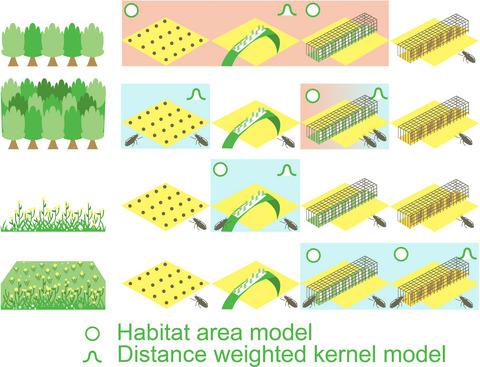当前位置:
X-MOL 学术
›
J. Appl. Ecol.
›
论文详情
Our official English website, www.x-mol.net, welcomes your
feedback! (Note: you will need to create a separate account there.)
The contribution of semi‐natural habitats to biological control is dependent on sentinel prey type
Journal of Applied Ecology ( IF 5.0 ) Pub Date : 2020-03-22 , DOI: 10.1111/1365-2664.13596 Niamh M. McHugh 1 , Steve Moreby 1 , Marjolein E. Lof 2, 3 , Wopke Werf 2 , John M. Holland 1
Journal of Applied Ecology ( IF 5.0 ) Pub Date : 2020-03-22 , DOI: 10.1111/1365-2664.13596 Niamh M. McHugh 1 , Steve Moreby 1 , Marjolein E. Lof 2, 3 , Wopke Werf 2 , John M. Holland 1
Affiliation

|
It is widely recognized that landscape factors affect the biological control of weed seeds and insect pests in arable crops, but landscape effects have been found to be inconsistent between studies. Here, we compare six different types of sentinels (surrogate prey that was either live insects or seeds) to measure the effects of semi-natural habitats at field to landscape scales on levels of biological control in winter wheat in the UK. Sentinels were located in fields adjacent to three boundary types: grassy margin, hedgerows or woodland to study the local scale effects and in landscapes of varying heterogeneity in study areas of 1-km radius. Overall, mean levels of predation were higher for most insect prey (60.8%) located on the ground compared to the crop (12.2%) and was lower for seeds (5.8%). Predation of sentinels on the ground was attributed to generalist predators. Semi-natural habitats had both positive and negative effects at field and landscape scales, but the response varied with the sentinel type. Herbaceous linear semi-natural habitats had positive effects at local scales for Calliphora vomitoria and Sitobion avenae sentinels and provide evidence that farmers can introduce linear herbaceous features to benefit biological control. In contrast, our distance-weighted kernel models identified a positive relationship between woody habitats and the predation of C. vomitoria and Chenopodium album. Natural aphid infestations were lower in landscapes with more semi-natural habitat. Synthesis and applications. Sentinels may be sensitive enough to detect variation in levels of biological control influenced by semi-natural habitats, but this study confirms that landscape effects differ for different types of sentinel prey. This implies that it may not be possible to categorize landscapes as pest suppressive using a single sentinel type. Future studies should therefore consider using multiple sentinels to give a better perspective on predation intensity. The resulting recommendations for farm management include planting woodland adjacent wheat fields infested with seed predators and positioning herbaceous linear habitats adjacent wheat fields infested with Sitobion avenae, particularly if fields are bordered by woody liner habitats due to their association with decreased S. avenae predation.
中文翻译:

半自然栖息地对生物控制的贡献取决于哨兵猎物类型
人们普遍认为,景观因素会影响耕地作物中杂草种子和害虫的生物防治,但研究发现景观效应并不一致。在这里,我们比较了六种不同类型的哨兵(活昆虫或种子的替代猎物),以测量田间和景观范围内的半自然栖息地对英国冬小麦生物控制水平的影响。哨兵位于与三种边界类型相邻的田地:草地边缘、树篱或林地,以研究局部尺度效应,并位于半径 1 公里的研究区域内不同异质性的景观中。总体而言,与作物 (12.2%) 相比,位于地面上的大多数昆虫猎物 (60.8%) 的平均捕食水平更高,而种子 (5.8%) 的平均捕食水平较低。地面哨兵的捕食归因于通才掠食者。半自然栖息地在田野和景观尺度上既有积极影响,也有消极影响,但响应因哨兵类型而异。草本线状半自然栖息地在局部尺度上对 Calliphora vomitoria 和 Sitobion avenae 哨兵具有积极影响,并提供证据表明农民可以引入线状草本特征以有益于生物防治。相比之下,我们的距离加权内核模型确定了木质栖息地与 C. vomitoria 和 Chenopodium 专辑的捕食之间存在正相关关系。在具有更多半自然栖息地的景观中,自然蚜虫侵染率较低。合成与应用。哨兵可能足够敏感,可以检测受半自然栖息地影响的生物控制水平的变化,但这项研究证实,不同类型的哨兵猎物的景观效果不同。这意味着可能无法使用单一的哨兵类型将景观归类为害虫抑制。因此,未来的研究应该考虑使用多个哨兵来更好地了解捕食强度。由此产生的农场管理建议包括在受种子捕食者侵扰的麦田附近种植林地,并将草本线性栖息地定位在受麦冬虫侵扰的麦田附近,特别是如果田地周围是木质衬垫栖息地,因为它们与减少 S. avenae 捕食有关。这意味着可能无法使用单一的哨兵类型将景观归类为害虫抑制。因此,未来的研究应该考虑使用多个哨兵来更好地了解捕食强度。由此产生的农场管理建议包括在受种子捕食者侵扰的麦田附近种植林地,并将草本线性栖息地定位在受麦冬虫侵扰的麦田附近,特别是如果田地周围是木质衬垫栖息地,因为它们与减少 S. avenae 捕食有关。这意味着可能无法使用单一的哨兵类型将景观归类为害虫抑制。因此,未来的研究应该考虑使用多个哨兵来更好地了解捕食强度。由此产生的农场管理建议包括在受种子捕食者侵扰的麦田附近种植林地,并将草本线性栖息地定位在受麦冬虫侵扰的麦田附近,特别是如果田地周围是木质衬垫栖息地,因为它们与减少 S. avenae 捕食有关。
更新日期:2020-03-22
中文翻译:

半自然栖息地对生物控制的贡献取决于哨兵猎物类型
人们普遍认为,景观因素会影响耕地作物中杂草种子和害虫的生物防治,但研究发现景观效应并不一致。在这里,我们比较了六种不同类型的哨兵(活昆虫或种子的替代猎物),以测量田间和景观范围内的半自然栖息地对英国冬小麦生物控制水平的影响。哨兵位于与三种边界类型相邻的田地:草地边缘、树篱或林地,以研究局部尺度效应,并位于半径 1 公里的研究区域内不同异质性的景观中。总体而言,与作物 (12.2%) 相比,位于地面上的大多数昆虫猎物 (60.8%) 的平均捕食水平更高,而种子 (5.8%) 的平均捕食水平较低。地面哨兵的捕食归因于通才掠食者。半自然栖息地在田野和景观尺度上既有积极影响,也有消极影响,但响应因哨兵类型而异。草本线状半自然栖息地在局部尺度上对 Calliphora vomitoria 和 Sitobion avenae 哨兵具有积极影响,并提供证据表明农民可以引入线状草本特征以有益于生物防治。相比之下,我们的距离加权内核模型确定了木质栖息地与 C. vomitoria 和 Chenopodium 专辑的捕食之间存在正相关关系。在具有更多半自然栖息地的景观中,自然蚜虫侵染率较低。合成与应用。哨兵可能足够敏感,可以检测受半自然栖息地影响的生物控制水平的变化,但这项研究证实,不同类型的哨兵猎物的景观效果不同。这意味着可能无法使用单一的哨兵类型将景观归类为害虫抑制。因此,未来的研究应该考虑使用多个哨兵来更好地了解捕食强度。由此产生的农场管理建议包括在受种子捕食者侵扰的麦田附近种植林地,并将草本线性栖息地定位在受麦冬虫侵扰的麦田附近,特别是如果田地周围是木质衬垫栖息地,因为它们与减少 S. avenae 捕食有关。这意味着可能无法使用单一的哨兵类型将景观归类为害虫抑制。因此,未来的研究应该考虑使用多个哨兵来更好地了解捕食强度。由此产生的农场管理建议包括在受种子捕食者侵扰的麦田附近种植林地,并将草本线性栖息地定位在受麦冬虫侵扰的麦田附近,特别是如果田地周围是木质衬垫栖息地,因为它们与减少 S. avenae 捕食有关。这意味着可能无法使用单一的哨兵类型将景观归类为害虫抑制。因此,未来的研究应该考虑使用多个哨兵来更好地了解捕食强度。由此产生的农场管理建议包括在受种子捕食者侵扰的麦田附近种植林地,并将草本线性栖息地定位在受麦冬虫侵扰的麦田附近,特别是如果田地周围是木质衬垫栖息地,因为它们与减少 S. avenae 捕食有关。











































 京公网安备 11010802027423号
京公网安备 11010802027423号